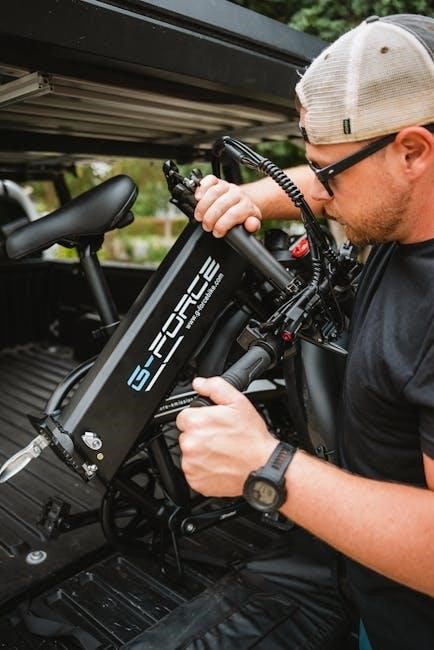Welcome to the Vector Charger Manual! This guide provides essential information for safe and effective use of your Vector smart automatic battery charger, designed for 12V lead-acid batteries.
1.1 Overview of the Vector Charger
The Vector Charger is a smart automatic battery charger designed for 12V lead-acid batteries, offering reliable and efficient charging. It features multiple charge rates (2, 10, and 25 amps) to suit various needs. The charger includes automatic voltage detection, overcharge protection, and a reconditioning function to extend battery life. Its compact design and user-friendly interface make it ideal for both automotive and marine applications. The Vector Charger ensures safe and optimal charging, preventing damage to the battery and electrical systems. With advanced features like alternator voltage check, it provides comprehensive battery maintenance. This charger is built for durability and performance, making it a versatile solution for all your charging requirements.
1.2 Importance of Reading the Manual
Reading the Vector Charger Manual is crucial for safe and effective use of your charger. It provides detailed instructions, safety precautions, and troubleshooting tips to ensure optimal performance. The manual helps you understand the charger’s features, such as automatic voltage detection and reconditioning functions, while preventing misuse that could damage the battery or charger. By following the guidelines, you can avoid risks associated with lead-acid batteries, such as explosions or electrical hazards. Additionally, the manual outlines warranty information and maintenance tips, ensuring your charger operates efficiently for years. Proper understanding of the manual is essential for maximizing the lifespan of both your charger and battery while maintaining safety standards.

Safety Regulations and Precautions
Always follow safety guidelines to avoid hazards. Avoid overcharging, ensure proper ventilation, and never use the charger for non-automotive systems. Adhere to instructions to prevent electrical risks and battery damage.
2.1 General Safety Tips for Battery Chargers
Always use the Vector Charger as specified in the manual to ensure safety. Avoid overcharging, as it can damage the battery and pose fire risks. Keep the charger away from flammable materials and ensure good ventilation to prevent hydrogen gas buildup. Never use the charger for non-automotive systems or non-lead-acid batteries, as this can cause explosions or injuries. Regularly inspect the charger and cables for damage. Avoid operating the charger in wet conditions or near water sources. Never modify the charger or battery, as this can lead to electrical hazards. Follow all safety guidelines to ensure safe and effective charging experiences.
2.2 Specific Safety Precautions for Vector Chargers
Always use the Vector Charger exclusively for 12V lead-acid batteries, as specified in the manual. Avoid using the charger for other battery types or as a power supply for low-voltage systems. Never modify the charger or battery, as this can cause electrical hazards. Keep the charger away from open flames or sparks, and ensure it is used in a well-ventilated area to prevent hydrogen gas accumulation. Avoid charging a fully charged battery, as this may reduce its lifespan. Do not use the charger near water or in wet conditions. Regularly inspect the charger and cables for damage. Follow all safety guidelines in the manual to ensure safe operation.

Understanding Your Vector Charger
Your Vector Charger is a smart, automatic 12V battery charger designed for lead-acid batteries. It offers high efficiency, safety, and reliability for automotive applications. Learn its features and operation to maximize performance and longevity.
3.1 Key Features of the Vector Charger
The Vector Charger is a smart, automatic battery charger designed for 12V lead-acid batteries. It features multiple charge modes, including 2A, 10A, and 25A options, catering to various charging needs. The charger includes advanced safety protections such as overcharge prevention, short-circuit protection, and thermal monitoring. Its intuitive LCD display provides real-time charging status, voltage, and current. The charger also offers automatic voltage detection and battery reconditioning functions to extend battery life. Designed for automotive applications, it ensures compatibility with most 12V lead-acid batteries. Durable construction and user-friendly controls make it a reliable choice for professionals and enthusiasts alike. Its compact design allows for easy storage and portability.
3.2 Compatible Battery Types and Models
The Vector Charger is specifically designed for 12V lead-acid batteries, ensuring compatibility with most standard automotive and marine applications. It is not intended for use with lithium-ion, gel, or other non-lead-acid battery types. Common compatible models include deep-cycle batteries, starter batteries, and dual-purpose batteries. Always verify the battery type and voltage before charging, as improper use can damage the battery or charger. For detailed compatibility, refer to the charger’s specifications or consult the battery manufacturer’s guidelines. The Vector Charger’s advanced technology supports a wide range of 12V lead-acid batteries, making it a versatile choice for various vehicles and equipment.

Preparing to Charge Your Battery
Before charging, determine the battery voltage and ensure the charger is set correctly. Inspect the battery, cables, and charger for damage. Charge in a well-ventilated area, away from flammable materials, and align settings with the battery type for safe and efficient charging.
4.1 Determining the Battery Voltage
To determine the battery voltage, refer to the vehicle’s manual or the battery label. Most automotive batteries are 12V, but some specialty or deep-cycle batteries may differ. Ensure the charger is set to the correct voltage (e.g., 12V or 6V) before connecting. Use a multimeter to verify battery voltage if unsure. Proper voltage matching is critical for safe and efficient charging. Always align the charger settings with the battery type to avoid damage or safety hazards. If uncertain, consult the manufacturer’s guidelines or contact a professional for assistance. Accurate voltage determination ensures optimal charging performance and extends battery life.
4.2 Checking the Charger and Components
Before charging, inspect the Vector charger and its components for any signs of damage or wear. Ensure all cables, clamps, and connectors are secure and free from corrosion. Verify that the charger’s display and indicators are functioning properly. Check the power cord for any frays or damage and ensure it is rated for the charger’s power requirements. If any components are damaged, do not use the charger until they are repaired or replaced. Regularly inspecting the charger and its parts helps prevent safety hazards and ensures reliable performance. Refer to the manual for specific inspection guidelines tailored to your Vector charger model. Proper maintenance extends the life of your charger and ensures safe operation. Always prioritize safety when working with electrical devices. Regular checks are essential for optimal functionality and user safety.

Charging Procedures
Follow the step-by-step guide to charge your battery safely and efficiently using the Vector charger. Select the appropriate charge rate, connect the cables properly, and monitor the process. Always use the charger for 12V lead-acid batteries only, as specified. Utilize automatic or manual modes based on your needs. Ensure the charger is plugged into a suitable power source and avoid overcharging. Refer to the manual for detailed instructions and safety precautions to ensure optimal charging and longevity of your battery. Proper charging procedures are essential for safety and performance. Always follow the manufacturer’s guidelines.

5.1 Step-by-Step Charging Instructions
Connect the Vector charger to a power source. Ensure the charger is placed on a stable, non-conductive surface. 2. Select the appropriate charge rate (2A, 10A, or 25A) based on your battery type and size. 3. Attach the positive (red) clamp to the battery’s positive terminal and the negative (black) clamp to the negative terminal or a metal surface on the vehicle. 4. Turn on the charger and allow it to automatically detect the battery voltage. 5. Monitor the charging process using the built-in indicators or the companion app. 6. Once charging is complete, disconnect the charger and clamps in the reverse order. Always follow safety guidelines to avoid overcharging or electrical hazards. Proper charging ensures battery longevity and safety.
5.2 Automatic vs. Manual Charging Modes
The Vector charger offers two charging modes: automatic and manual. The automatic mode is designed for convenience, as it detects the battery type and voltage, adjusting the charge rate accordingly. This mode is ideal for most users, as it minimizes the risk of overcharging and ensures optimal charging. The manual mode provides more control, allowing users to set the charge rate and voltage manually, which is useful for specific battery types or maintenance charging. Always refer to the manual for instructions on switching between modes. Automatic mode is recommended for standard use, while manual mode is best for experienced users or unique charging needs.
5.3 Monitoring the Charging Process
Monitoring the charging process is crucial for ensuring safety and efficiency; The Vector charger features built-in indicators, such as LED lights or a digital display, to show the charging status. Always observe these indicators to track progress. For automatic mode, the charger will automatically adjust the charge rate, and you can monitor the battery voltage and current on the display. In manual mode, regularly check the battery terminals and connections to ensure they are secure and free from corrosion. Refer to the manual for specific instructions on interpreting error codes or unusual behavior. Proper monitoring helps prevent overcharging, which can damage the battery and reduce its lifespan.

Maintenance and Care
Regularly clean the charger with a dry cloth and inspect cables for wear. Store the charger in a cool, dry place to ensure optimal performance and longevity.
6.1 Cleaning and Storage Tips
Regular cleaning and proper storage are crucial for maintaining your Vector Charger’s performance. Use a dry, soft cloth to wipe down the charger, avoiding harsh chemicals or moisture. Store the charger in a cool, dry place away from direct sunlight and humidity to prevent damage. Ensure all cables are neatly organized and free from tangles or kinks. Periodically inspect the charger and cables for signs of wear or corrosion. Avoid storing the charger near flammable materials or in areas with extreme temperatures. By following these tips, you can extend the lifespan of your Vector Charger and ensure reliable operation when needed.
6.2 Periodic Inspection of Charger and Battery
Regular inspection of your Vector Charger and battery ensures optimal performance and safety. Check the charger’s cables and connectors for signs of wear, fraying, or corrosion. Verify that all terminals are clean and secure. Inspect the battery terminals for corrosion and tighten connections if necessary. For the battery, monitor electrolyte levels (if applicable) and ensure they are within recommended ranges. Check the battery’s voltage using a multimeter to confirm it holds a charge. Perform these inspections every 3 to 6 months or after prolonged storage. Address any issues promptly to prevent damage and maintain reliability. Always disconnect the battery before performing inspections or maintenance.

Troubleshooting Common Issues
This section provides a troubleshooting guide for common problems, including error codes, charging issues, and connectivity problems, to help you resolve them efficiently and safely.
7.1 Identifying and Resolving Charging Problems
Common charging issues include the charger not turning on, battery not charging, or unexpected error codes. First, ensure all connections are secure and the charger is properly plugged in. Check for loose cables or corrosion on terminals. Verify the battery voltage matches the charger’s settings. If the charger fails to start, inspect the power source. For error codes, consult the error code section in this manual. Avoid overcharging, as it can damage the battery. If problems persist, disconnect the battery and restart the charging process. Regularly inspect the charger and battery for wear or damage. Always follow safety guidelines to prevent accidents.
7.2 Understanding Error Codes and Solutions
Vector chargers display error codes like E1, E2, E3, E4, and E5 to indicate specific issues. E1 signifies overvoltage, while E2 indicates under-voltage. E3 points to a faulty temperature sensor, and E4 suggests a charging timeout. E5 denotes a communication error. To resolve these, restart the charger, check connections, and ensure the battery type matches settings. For E3, verify the sensor is clean and properly connected. If issues persist, consult the manual or contact support. Regular maintenance and inspections can prevent many errors. Always follow the troubleshooting steps to ensure safe and efficient charging. Refer to the error code section for detailed solutions and guidelines to restore normal operation quickly.

Additional Accessories and Compatibility
Vector chargers are compatible with accessories like UMT-2xD, UMT-4xD, AS-110, TP-100, ATT-210, MC-811, and UBR-816, enhancing functionality. Refer to the Vector catalog for details.
8.1 Recommended Accessories for Vector Chargers
Vector chargers are compatible with a range of accessories to enhance functionality. These include UMT-2xD and UMT-4xD for advanced battery testing, AS-110 for voltage stabilization, and TP-100 for temperature control. Additionally, ATT-210 provides real-time monitoring, while MC-811 and UBR-816 offer maintenance and backup power solutions. These accessories ensure optimal performance and extend the capabilities of your Vector charger. Refer to the Vector catalog for detailed compatibility and installation instructions. Using genuine Vector accessories guarantees safety and reliability, ensuring your charging system operates at its best. Always check the product manual for specific recommendations tailored to your charger model.

Warranty and Customer Support
Your Vector charger is backed by a comprehensive warranty. For warranty claims, register your product and contact Vector’s customer support team. They offer assistance, repairs, and replacements as per terms and conditions.
9.1 Warranty Information and Claims
Your Vector charger is protected under a limited warranty that covers manufacturing defects for a specified period from the date of purchase. To file a warranty claim, ensure your product is registered and contact Vector’s customer support. Provide proof of purchase and a detailed description of the issue. Approved claims will result in repairs or replacements at no additional cost. Warranty terms vary by model and region, so review your manual for specific details. Keep your receipt and registration confirmation for verification purposes. Vector’s customer support team is available to assist with inquiries and ensure your charger performs optimally throughout its warranty period.
Thank you for taking the time to read the Vector Charger Manual! By following the guidelines and safety precautions outlined, you’ll ensure optimal performance and longevity of your charger and batteries. Remember to always refer to this manual for any questions or concerns. Regular maintenance and proper use will maximize efficiency and reliability. Vector is committed to providing high-quality products, and we trust this manual has equipped you with the knowledge to use your charger effectively. Should you have further inquiries, our customer support team is ready to assist. Enjoy the benefits of your Vector Charger for years to come!

